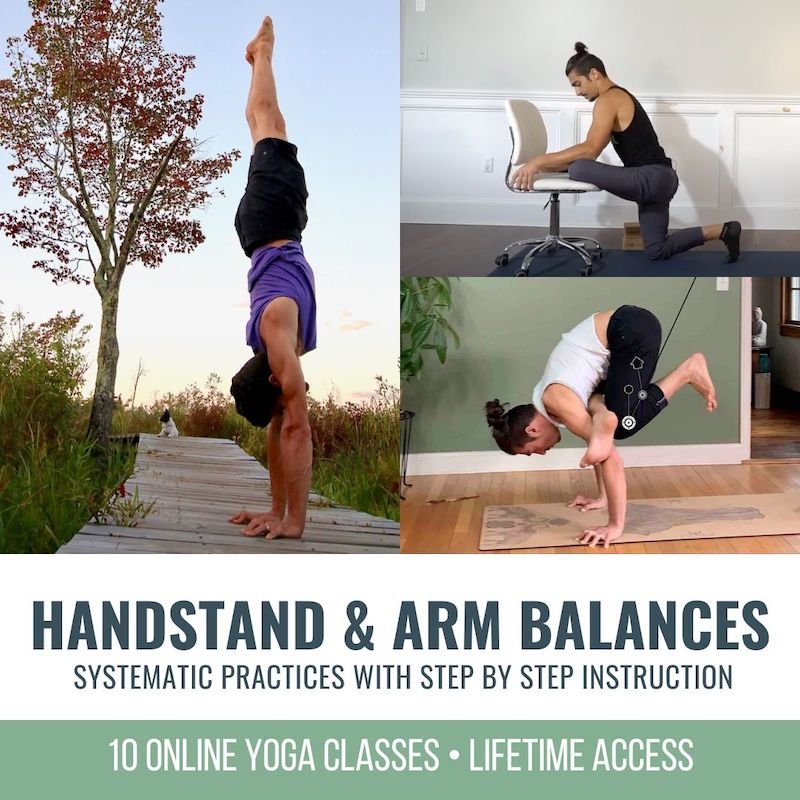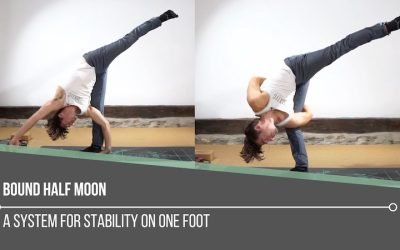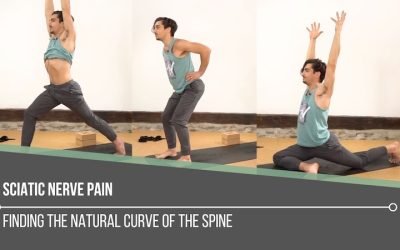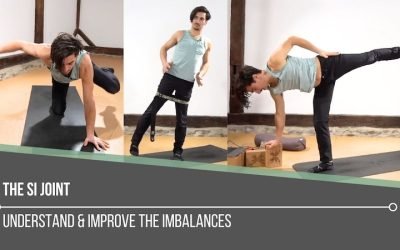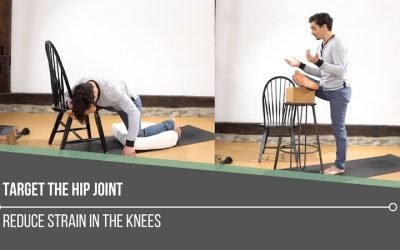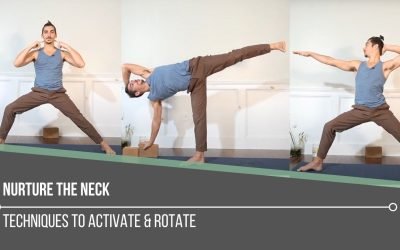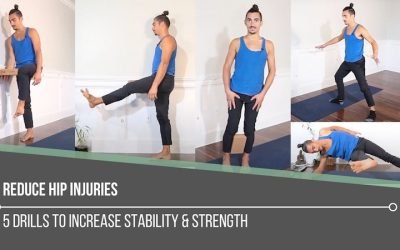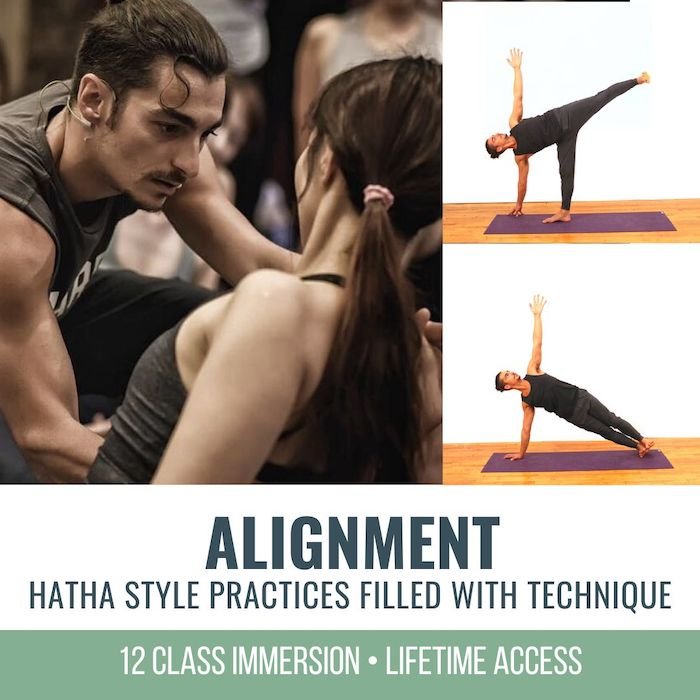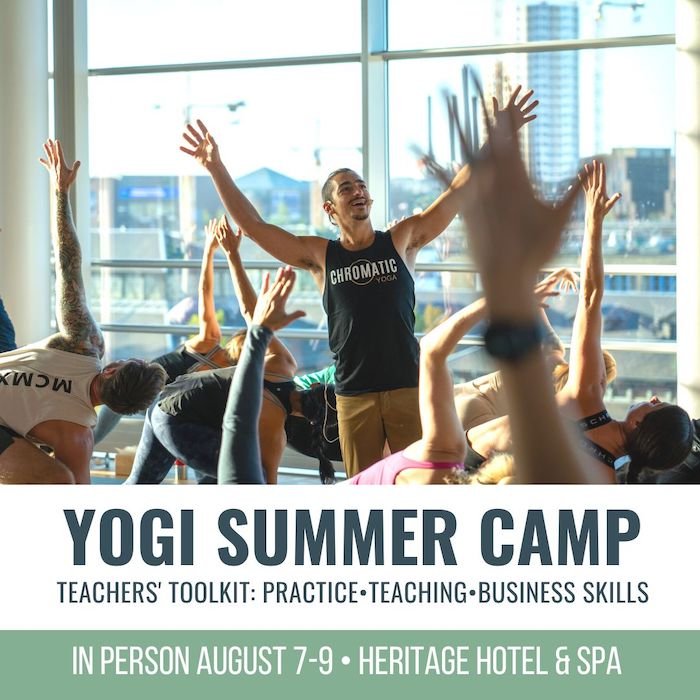Bound Half MoonBADDHA ARDHA CHANDRASANABOUND HALF MOON The elements involved in Bound Half Moon are many. There’s a lot at work and more than meets the eye. Our ears, eyes, muscles, and proprioception help us to balance. When it comes to which element carries more...
Shoulder Secrets
Shoulder Secrets
bhujapidasana
SHOULDER SECRETS
When approaching arm balances, it’s not unusual to go straight to a focus on the wrists. Having to bear our weight into the wrists while balancing our body weight can be an intimidating thought (especially if we don’t have the right tools or “secrets”) that assist in the reduction of strain and pressure. Arm balance postures are much more layered than simply requiring strength in the wrists. We can allow the shoulders to take on some of the responsibilities. In today’s video, Matt demonstrates the key actions (“shoulder secrets”) that will help us to feel more in control and at ease in our arm balance postures.
HANDSTAND AND ARM BALANCES
REGISTRATION NOW OPEN
- 10 Chromatic Yoga practices with founder Matt Giordano
- Full length 75 minute classes
- Each Yoga class includes handstand drills and 1 arm balance breakdown
- Each class includes warm ups, sun salutations, standing postures and preparatory postures for the selected arm balance of the day
- Improve your body awareness and advance your practice
- Technique, biomechanics, and alignment at the forefront
- 12 Continuing Education hours with Yoga Alliance
- 12 Accredited Hours with the Chromatic School of Yoga
- Step-by-Step instruction for increased accessibility
- Improve strength, balance, flexibility, and proprioception
- Appropriate variations and modifications for all levels
POWER POINTS OF A POSTURE
Understanding the connection between our foundation and “power points” are the key to mastering poses. Matt goes into detail about in his online Pose Factory course.
Our foundation is what’s in contact with the ground—feet in standing poses or hands in arm balances. The power point is the part of the torso closest to this foundation, acting as the source of strength. For arm balances, the power point is the shoulders, channeling energy from the ground through the arms. When practicing with Matt, we know that grip strength in our hands and wrists is important, but the real stability comes from an engaged shoulder girdle. Without this connection, the poses in today’s video may feel unstable or collapse.
The shoulders serve as a bridge, channeling energy from our core to our foundation. By focusing on this connection, we transform our poses from shaky to steadfast, embodying both strength and grace.
WATCH THE VIDEO
SHOULDER SECRETS: CREATING STRENGTH & FREEDOM IN ARM BALANCES
TAKE THE WEIGHT OFF OF THE WRISTS
Supporting our wrists in arm balances begins with activating our shoulders. Matt teaches us that the key is to focus on the protraction of the scapula, the “shoulder secret”in today’s arm balances. It’s the primary action that significantly reduces strain on the wrists. Protraction along with flexion of the spine, creates a powerful connection from the shoulder girdle to our hands. This not only makes the wrists feel lighter but also builds strength and stability in arm balances. While some arm balances demand more wrist strength, we learn to rely more on the shoulders in the arm balances from today’s video. Engaging the shoulders effectively transforms the balance of effort, making them feel more accessible and sustainable. With mindful activation, our wrists no longer bear the brunt of the work, and the power of our shoulder girdle supports us in finding ease and strength in these postures.
200 HOUR ONLINE TEACHER TRAINING
GET CERTIFIED & DEEPEN YOUR YOGA PRACTICE
- Deepen your yoga practice
- Build confidence speaking in front of groups in person and online
- Learn foundational class structures and templates
- Learn techniques for a wide range of yoga postures
- Get certified and highly qualified to teach yoga
- Yoga Alliance Globally Recognized Certification Program
SHOULDER PRESSING POSE ON BLOCKS
While Matt demonstrates access to Shoulder Pressing Pose (Bhujapidasana) in the video, we learn exactly how and when to employ the action in the “power point” (protraction of the scapula). For greater access, he utilizes blocks. Here are the steps:
- Slide 2 yoga blocks between wide feet
- Bend the knees and flex the spine
- Slide the blocks wide (behind the heels)
- Sit onto bent elbows
- Lift the heels up and point the feet
- Push the shoulder blades apart
- Flex the spine
- Squeeze the legs in
It’s right after step 5, that if we don’t create protraction of the shoulder blades, we will get heavy in the wrists.
Armed with our shoulder secrets and the foundation from Shoulder Pressing Pose, Matt then demonstrates how we can gain more access to Firefly Pose.
300 HOUR ONLINE TEACHER TRAINING
GET 500 HOUR CERTIFIED AS A MASTER TEACHER
Master your skill set as a teacher through refined techniques, anatomy, biomechanics, sequencing, philosophy, meditation techniques, theming, yoga business, and much more!
- Get 500 hour certified
- Learn anatomy, biomechanics, asana techniques
- Expand your teaching skills
- Masterful sequencing and verbal delivery
- Learn meditation and breathwork techniques
- Transformative tools: theming, dharma talks, satsang
EFFORT WITH EASE
Arm balances embody the dance between effort and ease, where strength meets freedom. True stability comes from engaging the shoulders and harnessing their power, allowing the wrists and hands to feel light and supported. This balance of activation and release creates a pose that feels both grounded and expansive. Effort lies in the mindful protraction of the scapula and the alignment of the body, while ease comes from trusting the connection between our foundation and our power point. When shoulders and wrists work in harmony, the pose transforms from a struggle into a flow, giving us the freedom to explore the strength within our bodies. As we explore these principles in arm balances, the struggle fades, leaving behind a practice that embodies strength, confidence, and lightness.
With Matt’s guidance, we can embrace this balance and experience the joy of mastering effort with ease.
Register for Matt’s January 2025 online immersion Handstand & Arm Balances for a deeper dive and greater access into balance postures.
The 200 Hr. Teacher Training: Click Here to See the Next Start Date
The 300 Hr. Advanced Teacher Training: Click Here to See the Next Start Date
Article by Trish Curling
Video Extracted From: Revelation Immersion
ONLINE ANATOMY COURSE
- Accessible, exciting, and easy to learn
- Anatomy and biomechanics for yoga
- Appropriate for both teachers and students
- Learn joint alignment vs pose alignment
- Demystify yoga poses and transitions
- Release aches and pains
- Learn how to avoid common injuries
- Caters to all levels with modifications and props
- 20 hours Continued Education Credits with Yoga Alliance
- 20 hours toward Chromatic Yoga Certification and 300 Hour
- Lifetime access
Continue Learning
Bound Half Moon
Sciatic Nerve Pain
Sciatic Nerve Painhip strengthSCIATIC NERVE PAIN The sciatic nerve runs from the lower back through the glutes and down the leg, making it one of the longest nerves in the body. Because of its length, it can easily become irritated or pinched, leading to pain anywhere...
The SI Joint
The SI JointalignmentTHE SI JOINT What is the SI Joint? To understand what it is, we must discuss all that surrounds it. First, the Sacrum is a triangular-like shaped bone that sits between the two sides of the pelvis (the left Ilium and right Ilium). Now each Ilium...
Target The Hip Joint
Target The Hip JointalignmentTARGET THE HIP JOINT Unlike the hip joint, the movement available at the knee is primarily meant for flexion and extension. When we engage in hip opening postures in our yoga practice, there can be a great impact on both the hip and the...
Nurture The Neck
Nurture The NeckalignmentNURTURE THE NECK The neck is not often the shining star of our yoga practice, yet it is an integral part. Too often, we may only offer more attention if we’re feeling pain in a particular posture. It’s important however, for us to be...
Reduce Hip Injuries
Reduce Hip InjuriesmobilityREDUCE HIP INJURIES The hip joint carries a great deal of responsibility. It supports many of our key movements in our daily lives. With all of its responsibility and involvement with how we move, it can act as a protector, while still...
THE FREE TECHNIQUE PACK
When You Subscribe, You Will Get Instant Access to
- the Technique Pack: 15 yoga pose breakdowns
- exclusive online course discounts
- exclusive blogs and videos

